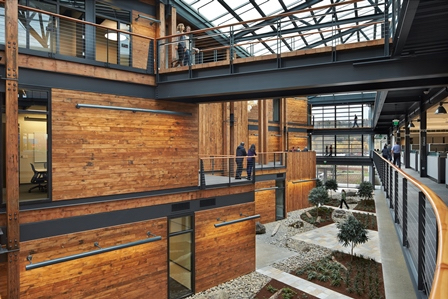
GSA Looks Back at the American Recovery and Reinvestment Act
Photo: Federal Center South near Seattle, WA.
Post filed in: Green Building | Green Buildings | Public Buildings Service | Sustainability
In 2009, President Obama signed into law the American Recovery and Reinvestment Act (ARRA), to provide $787 billion in economic stimulus during the recession. The General Services Administration (GSA) received $5.5 billion of ARRA funds to convert federal buildings to high-performance green buildings and to build new energy-efficient federal offices, courthouses and land ports of entry.
Now that seven years have passed since ARRA, let’s look back at five of the most important projects from that era.
Federal Center South
Redevelopment and modernization of the Federal Center South complex near Seattle, WA, began in July 2010. We invested $72 million in ARRA funding to develop a state-of-the-art office building that meets the current and future needs of the Army Corps and its Seattle workforce. The building has many sustainable features, such as 100% filtered outside air, a rainwater collection system that captures water and stores it in a 25,000 gallon cistern for use in toilet flushing, irrigation, cooling, and landscaping. It was able to save 40% energy in its first year.
Denver Federal Center
The solar energy project at the Denver Federal Center (DFC) in Lakewood, Colo., involves roof, ground, and carport-mounted photovoltaic systems. It is GSA’s vision to make the facility the most sustainable federal campus by 2020. The 34,564 solar panels will provide more than 15 percent of the Denver Federal Center’s electrical needs, while reducing the demand for common grid-supplied electricity and saving utility costs of more than $700,000 per year. GSA’s first 1.2 MW PV system came on line in December 2007 and two years later, GSA received ARRA funding to add nearly 7 MW more solar for a combined capacity of 8 Megawatt DC photo voltaic system. This system provides approximately 22% of the DFC’s electrical needs and it’s enough to power 1,064 residential homes for one year.
Whipple Federal Building
GSA replaced the old, inefficient heating, ventilation, and air conditioning system at the Bishop Henry Whipple Federal Building in Fort Snelling, MN, with a state-of-the-art heating and cooling system that uses geothermal ground wells. This system will be one of the largest installed in the upper Midwest and will be about 72 percent more efficient than traditional electric heating and air conditioning systems.
Jackman Land Port of Entry
During the summer of 2010, GSA installed two wind turbines at the border crossing facility in Jackman, Maine. The turbines greatly reduce the consumption of traditional energy sources by supplying half of the facility’s energy needs with renewable wind power.
Federal Office Building at 50 United Nations Plaza
The 50 United Nations Plaza Federal Building, built in 1933, is a seven story steel frame and masonry Beaux-Arts Neo-Classical style building located in the heart of San Francisco. With ARRA funding, it underwent a full modernization and renovation, including a seismic upgrade, installation of more efficient building systems, the creation of a roof garden, and a reimagining of the interior spaces that resulted in a more modern and efficient workplace. The building was recently designated LEED Platinum by the U.S. Green Buildings Council as a result of this project and has helped revitalize the San Francisco Civic Center neighborhood.
GSA used ARRA funds to help renovate and build green federal buildings with sustainable energy efficient designs that helped save taxpayer dollars. These projects also served as economic catalysts in their respective communities and will continue to stimulate job growth.

 U.S. General Services Administration
U.S. General Services Administration
